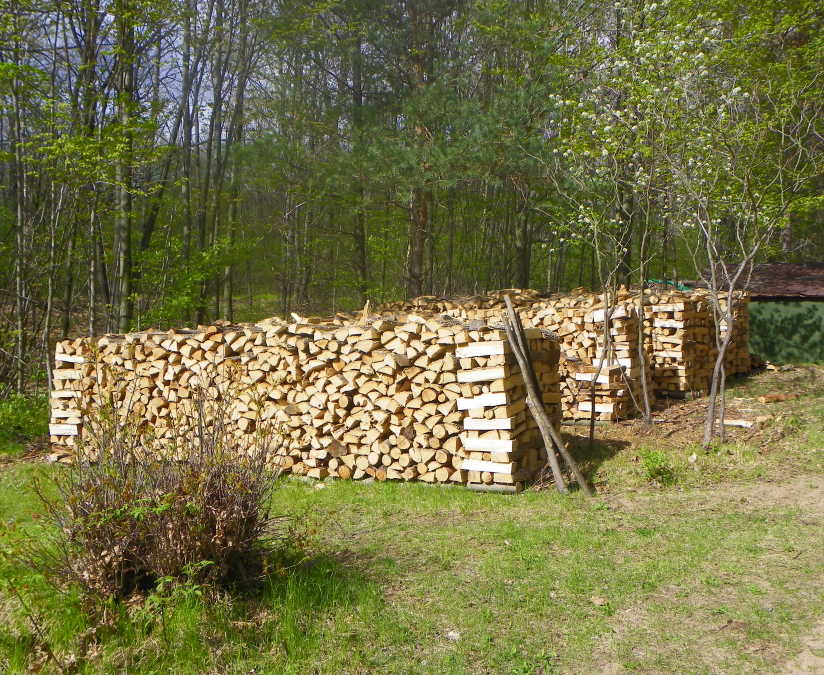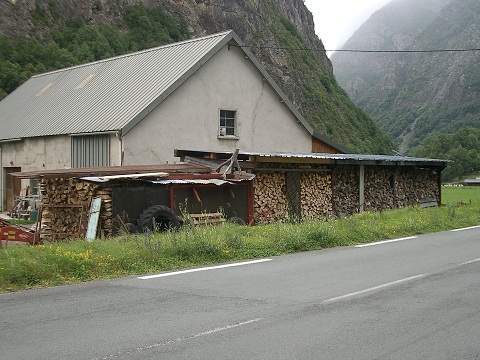How to stack firewood for best results
Got some stacking tips of your own? Share them below...
Learning a few tricks for how to stack firewood can keep your wood pile neat and tidy and guarantee that your firewood is seasoned nicely by the time you want to use it.
For many users of wood stoves stacking firewood gives a chance to show off their artistic talents and preen for the neighbours (my stack is bigger than your stack... )

The above stacks belong to "Backwoods Savage", image used with thanks. Each stack contains 2 cords of firewood. 4 Cords would last us just one heating season. The stacks are totally uncovered to allow maximum wind exposure.
When considering how to stack firewood we must think about a few important things:
- It needs to be stable - you don't want to spend two hours stacking wood for it to blow down in a strong wind
- It needs to be tall - you want your wood exposed to the wind as much as possible so it seasons well, and the taller you stack it the less floor space it takes up
- It needs to be out of contact with the ground - wood in contact with soil soaks up moisture and rots
- It needs to be stacked vertically - a very easy mistake to make when stacking firewood is to have a pile that leans towards you as you build
- You want to try to minimise firewood handling - thinking about where you stack your firewood can help reduce some of the back ache of handling firewood
- You need to think about location - stacking firewood to season it needs exposure to both wind and the sun.

This farm house has all it's firewood stacked in sheds. The roof keeps the rain and snow off, but the open sides give good ventilation. The colour change probably indicates one year's worth of wood, cut recently and left to season.
How to stack firewood - General Tips
Keeping it upright
With your head down stacking away it is quite easy to not notice that a pile is growing out of line, and once it has gone away from vertical it is next to impossible to fix it without taking the stack apart and starting again. To stop it getting that bad you should step back every now and then and look along the pile. If it is growing out towards you then make any adjustments before carrying on. If you need to get the odd piece back in place then the best way is to use another piece of wood to tap it back into line.
Using the wood's natural taper
Most split firewood will have a natural taper down its length, and you can use this to help keep the upper surface of the firewood stack horizontal. As you notice the top pile going off horizontal simply make sure that the next piece you lay is orientated so that the new upper surface is back nearer to being flat. Once you start building wood piles you'll get the hang of this very quickly.
Dealing with oversized logs
Our previous home had a log shed built under a section of sloping eaves. It held a bit less than a quarter of a cord - enough for a few weeks of occasional use in the winter. Our firewood supplies were all a bit random - odd pieces of wood, different sizes, lumpy shapes and strange lengths. After a few months we'd inevitably end up with a collection of odd logs, all too large to burn in our stove, clogging up the wood pile near the house.
To avoid this it is really a good idea to separate out these oversized and misshapen logs before you first stack them for seasoning. You can then split them down further, or take the chainsaw to them if needs be.
Covering or not covering
Our ultimate aim is to season the wood quickly, so the question of whether to cover it or not is important. In general most people, if they cover their firewood at all, cover only the top to prevent rain falling on the top of the pile. The sides are left exposed to allow as much air circulation as possible. This covering may be a piece of tarpaulin weighed down with some heft logs, bits of corrugated iron or even a substantial wood shed.
Covering the sides is generally counter productive as the reduced air circulation effectively stops any further drying - just think what happens if you leave wet clothes in a plastic bag, instead of hanging them out on the line.
What you decide will depend on your circumstances. Here in the UK a wood shed is a good idea - we have long wet and rainy winters and exposed firewood just gets wetter the longer it is out for. In Northern States of the USA, which have long periods of sub zero temperatures with snow and ice rather than rain, the air humidity can actually be very very low and logs continue to season through the depths of winter.
How to stack firewood? - Getting the ends right
By using an end post
You can make a quick and sturdy end post by sharpening the end of a length of pole and simply bashing it into the ground. This is a great solution if you are doing all your firewood cutting, splitting and seasoning out in the woods as suitable straight poles should be plentiful.
As you carry on stacking firewood you rest more and more logs against the end post and can easily get a sturdy log pile around 4' high (1m 20cm). If you are fortunate you may find a pair of well positioned trees which can act as the two end pieces - I saw this done recently to good effect in Austria. Look out though, trees shift around in strong winds and your stack could topple!
By using a criss-cross end
Another good alternative is to make an end tower of logs stacked in alternating directions. This tower is stable and can support the remaining wood pile.
This is a slightly trickier solution - it depends on having enough evenly sized, well matched pieces so that you can build a stable tower. If the pieces are all odd sizes and shapes you will struggle to get a decent tower. To avoid this problem you can start building the two end towers as you construct the remaining wood stack - as you stack the middle separate out likely looking, well matched pieces for you end towers.
Again, don't forget to raise the whole log pile up on poles or your bottom logs will soak up moisture.
NB: when measuring cords of firewood, wood stacked in alternating directions takes up substantially more space than when close packed. Some unscrupulous merchants try to sell firewood stacked this way. While criss-crossed end towers are generally accepted never buy a 'full cord' where the wood has all been stacked this way.
With a few bits of old twine
I stumbled on this method while researching for this page - I don't claim it as my own and haven't had a chance to try it out yet however it looks like a great way to get good tall, stable firewood stack, even with uneven pieces of wood.
Effectively you tie the logs that make up the end of the stack to pieces that are locked deeper into the wood pile. The weight of the logs in the centre of the pile holds the ends in place so you can keep building the pile higher and higher. The way to do this is to just tie two logs together with a length of twine, but with 18" or so of slack between them. Place the two logs on the pile - one in the centre and one right out on the end - and stack more logs up on top to hold them both in place.
Repeat this every few layers until you reach the required height. This is particularly useful if you need tall and narrow piles, for example up against the eaves of your home, when you are not able to put posts in.
And finally...
You'll quickly grow beyond the tips I've included here and will come up with solutions that best suit your own needs. If you have tips of your own, or questions pertaining to stacking wood, please share them with the form below.
Do you have a great way of stacking firewood?
Do you have a favourite way of stacking firewood, or some photos to show off? Share them here!
What Other Visitors Have Said
Click below to see contributions from other visitors to this page...
Wood Rack
I had a welder buddy build this rack for me. It’s 12’x6’ and is 2 sided. Right now it’s full and both sides will be ready to burn in the fire pit in the …
Tipping firewood stacks? Easy To fix!
Hello All
If you have a pile of wood that has a lean to it, or is just needs a few adjustments it is quite easy to tap it back into place one log at …
Update of Macs World
Please remove the sketch that was attached to my story. It was submitted in error and I found no way to change it. Here it was was meant to be sent. …
Mac's World - Stacking using pallets and cinder blocks.
Good morning:
My kids say I have OCD. I tell them I have CDO: It's like OCD but the letters are in alphabetical order like they should be! I've been …
Living off the grid
We have a one room log cabin in the woods of north-west Montana. It's a twenty minute drive on an unpaved road to the nearest neighbours and town. We cut …
Stacking Wood Between Trees : Not Such A Good Idea
This may sound like a great idea but think about what happens to those trees when the wind blows; "they move". I spent two to three hrs stacking a buitiful …
Steel Rails for Stacking
In my part of the world any wood laying on the ground will be attacked by termites and or other types of critters. Most trees are attacked soon after the …
